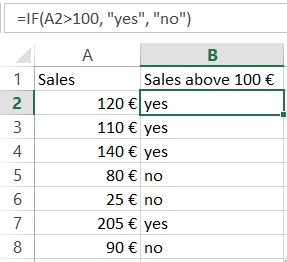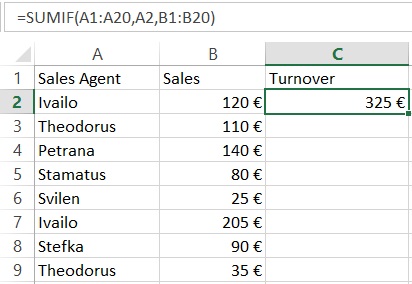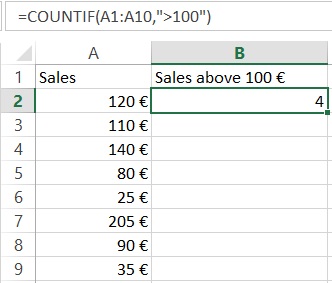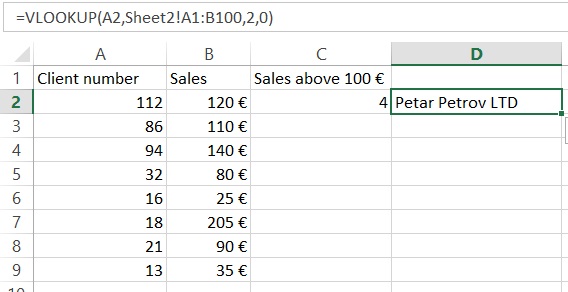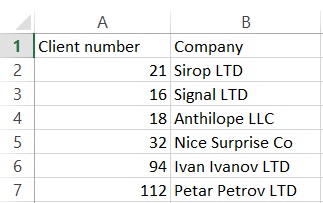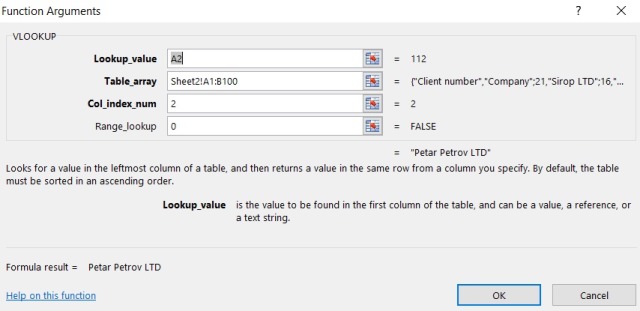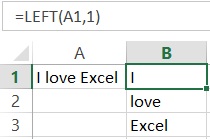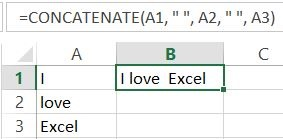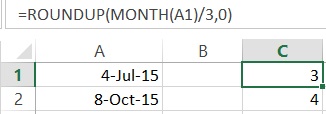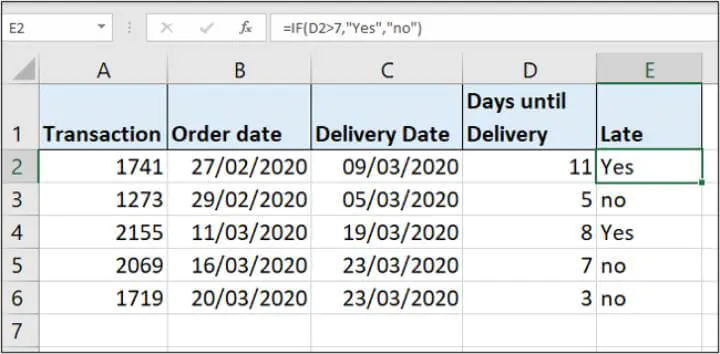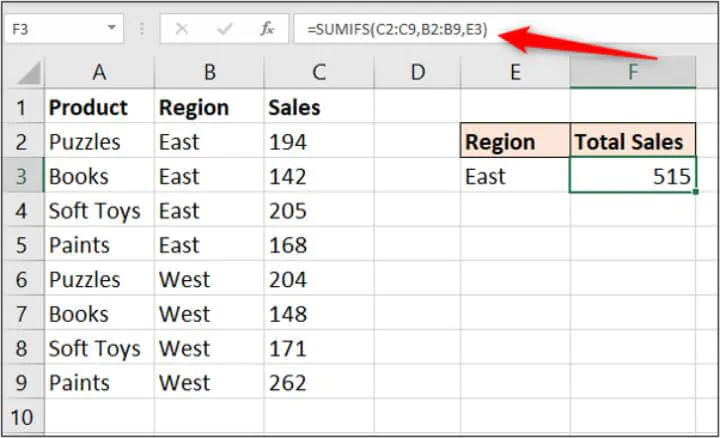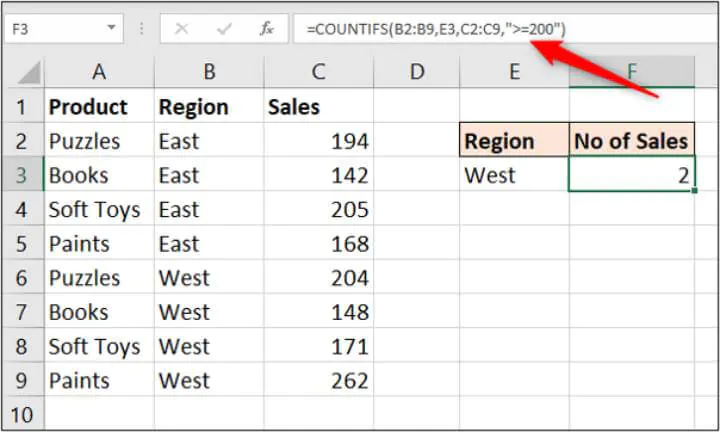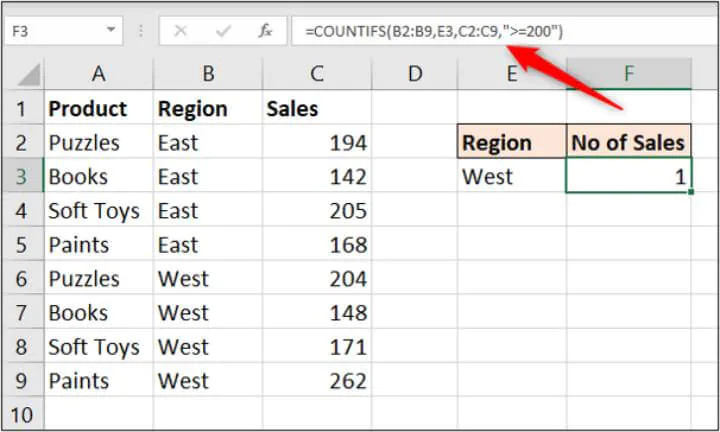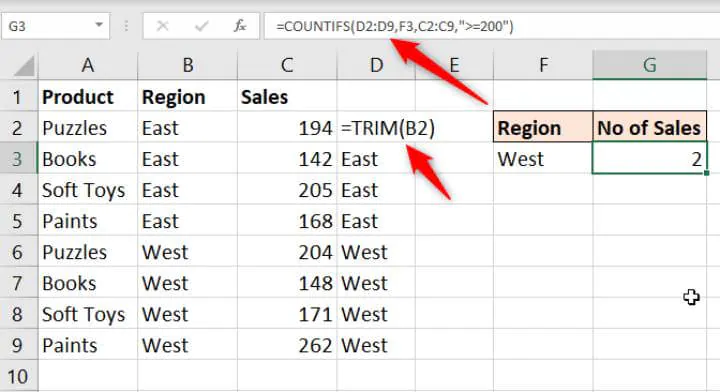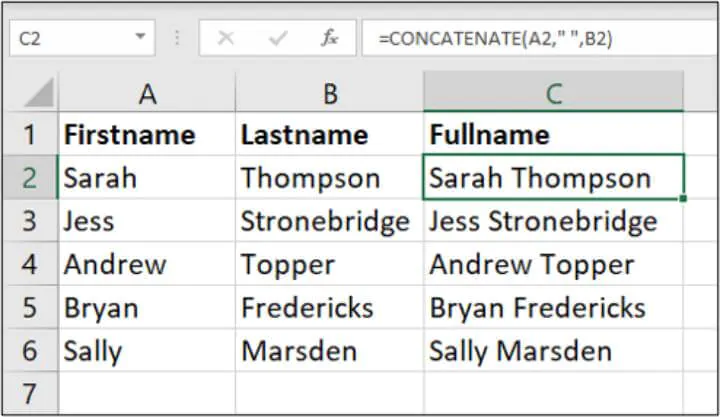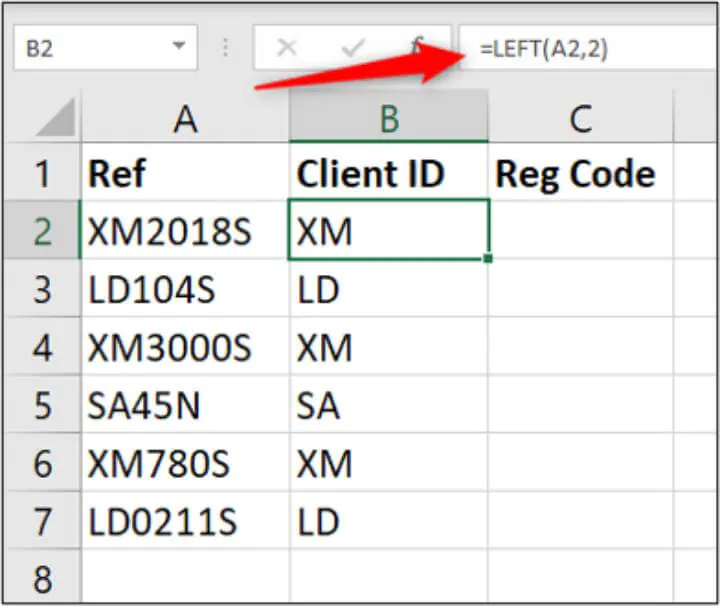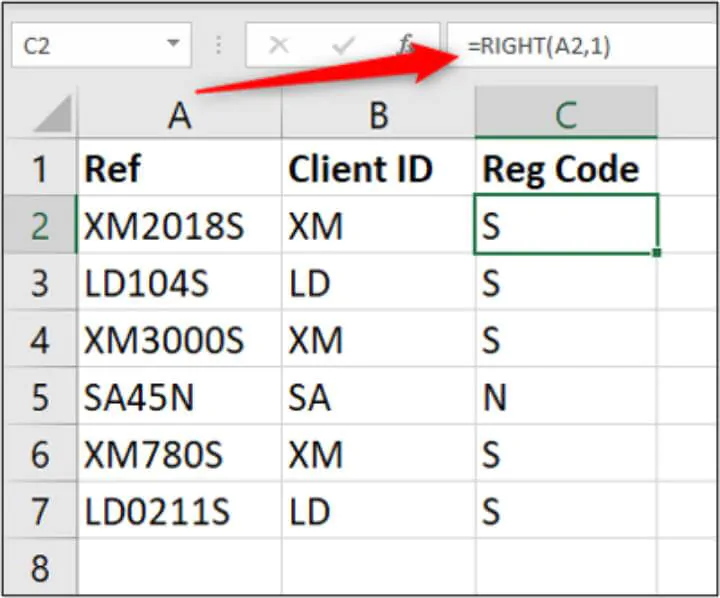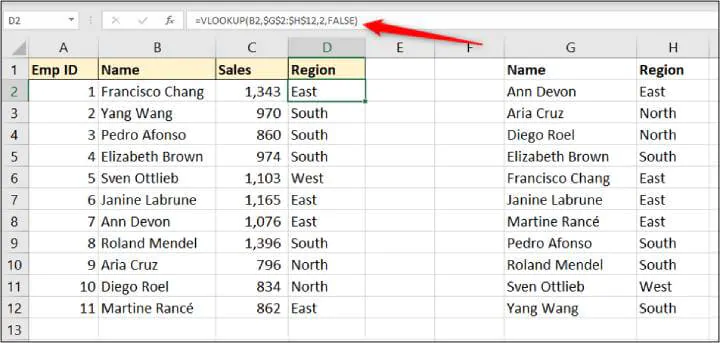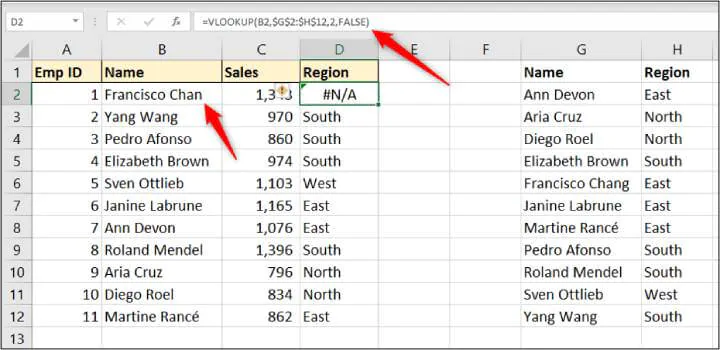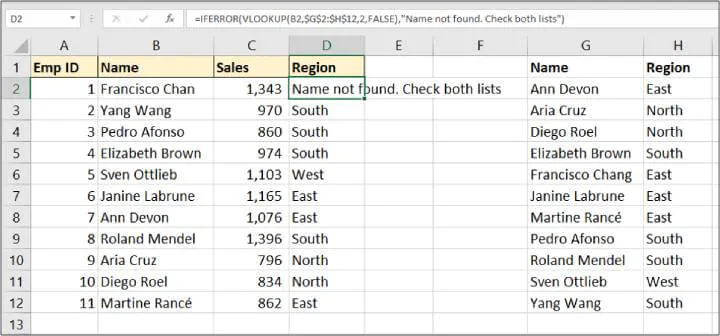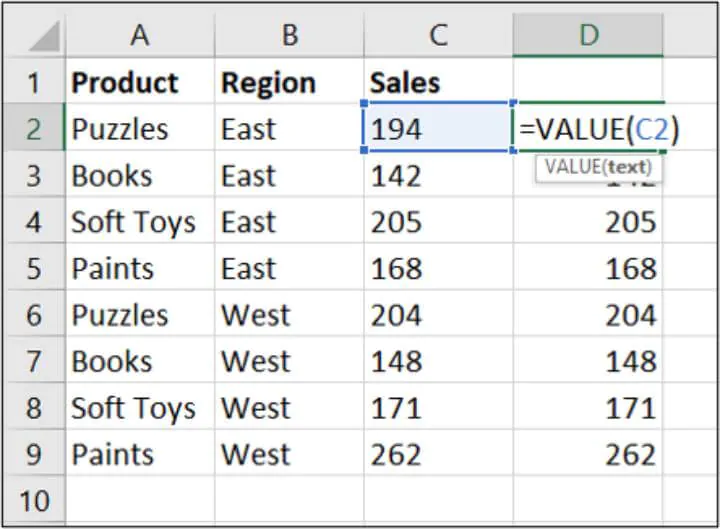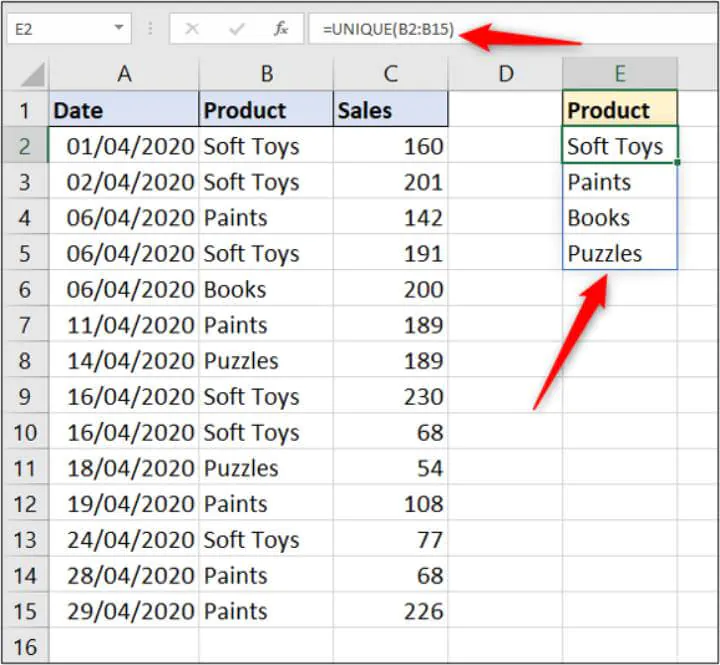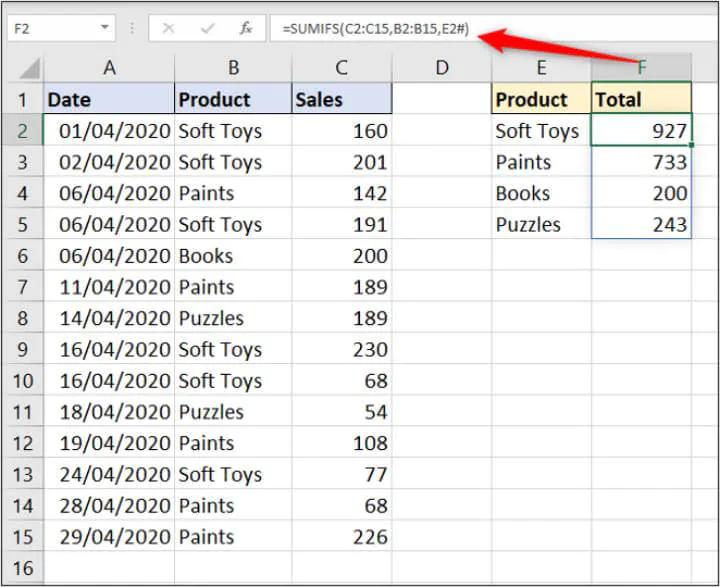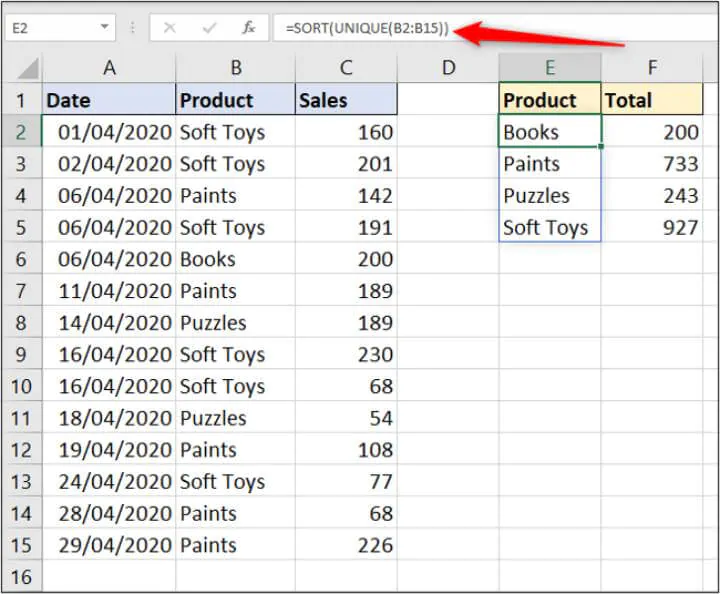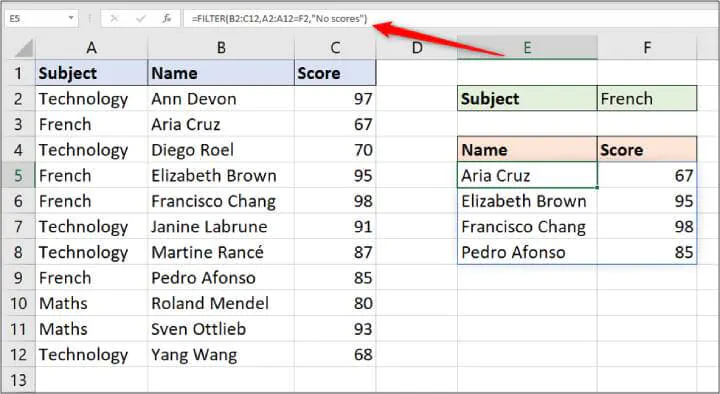Let’s check out the 10 most used Excel functions. Visit our section about functions for detailed explanations and more awesome functions.
Tip: download the Excel file and try to insert these functions.
1. COUNT
To count the number of cells that contain numbers, use the COUNT function in Excel.
Note: use COUNTA to count all cells that are not empty. COUNTA stands for count all.
2. SUM
To sum a range of cells, use the SUM function in Excel. The SUM function below sums all values in column A.
Note: you can also use the SUM function to sum an entire row. For example, =SUM(5:5) sums all values in the 5th row.
3. IF
The IF function checks whether a condition is met, and returns one value if true and another value if false.
Explanation: if the score is greater than or equal to 60, the IF function shown above returns Pass, else it returns Fail. To quickly copy this formula to the other cells, click on the lower right corner of cell C2 and drag it down to cell C6.
4. AVERAGE
To calculate the average of a group of numbers, use the AVERAGE function (no rocket science here). The formula below calculates the average of the top 3 numbers in the range A1:A6.
Explanation: the LARGE function returns the array constant {20,15,10}. This array constant is used as an argument for the AVERAGE function, giving a result of 15.
5. COUNTIF
The COUNTIF function below counts the number of cells that contain exactly star + a series of zero or more characters.
Explanation: an asterisk (*) matches a series of zero or more characters. Visit our page about the COUNTIF function for more information and examples.
6. SUMIF
The SUMIF function below sums values in the range B1:B5 if the corresponding cells in the range A1:A5 contain exactly circle + 1 character.
Explanation: a question mark (?) matches exactly one character. Visit our page about the SUMIF function for more information and examples.
7. VLOOKUP
The VLOOKUP function below looks up the value 53 (first argument) in the leftmost column of the red table (second argument). The value 4 (third argument) tells the VLOOKUP function to return the value in the same row from the fourth column of the red table.
Note: visit our page about the VLOOKUP function to learn more about this powerful Excel function.
8. MIN
To find the minimum value, use the MIN function. It’s as simple as it sounds.
9. MAX
To find the maximum value, use the MAX function.
Note: visit our chapter about statistical functions to learn much more about Excel and Statistics.
10. SUMPRODUCT
To calculate the sum of the products of corresponding numbers in one or more ranges, use Excel’s powerful SUMPRODUCT function.
Explanation: the SUMPRODUCT function performs this calculation: (2 * 1000) + (4 * 250) + (4 * 100) + (2 * 50) = 3500.
41 EXCEL EXPERTS WEIGH IN
Brought to You by AutomateExcel.com
Microsoft Excel has hundreds of functions. Even experienced Excel users can find themselves wondering if they are using the best Excel formulas for their projects.
With that in mind, we polled 41 Excel experts and asked them the question: What is the most under-used Excel function? Their answers are listed below.
Want to master the 30 most-used Excel Functions?
CHOOSE Function — 4 Votes
The CHOOSE function was my vote for the most under-used Excel function. It’s easy to understand and very powerful. CHOOSE allows you to select one of up to 254 values or options based on an index number. — Michael from Excel Bytes.
As John from How to Excel implies, this might not sound like much, but in the right circumstance it can be very powerful: I remember when I first met CHOOSE. I thought to myself, «Wow, what a boring function. All it does is choose an item in your list based on an index number. Doesn’t INDEX already do that?» It looks like a very simple function at the outset, but when you combine it with other formulas it can be quite powerful.
My favorite use of the CHOOSE Functions is this: Let’s say you have 4 worksheets: a Forecast sheet, a Budget sheet, a Trailing 12 sheet, and a Summary sheet. On the Summary sheet, you use drop-downs to select which sheet’s data to show:
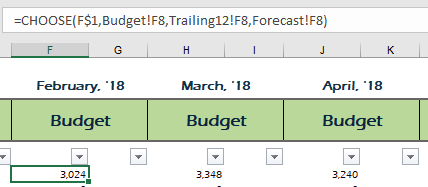
In the above example, the CHOOSE function allows you to read data from one of three sheets. Cell F$1 contains a MATCH function that looks to see what option was selected from the drop-down (drop-down currently reads «Budget») and returns the corresponding number, which is used by the CHOOSE function. You can see that by using the CHOOSE function you can select values from different sheets, while avoiding volatile functions like INDIRECT.
Lookup Formulas — VLOOKUP, HLOOKUP, INDEX, and MATCH — 5 Total Votes
The lookup functions are hands-down some of the most important Excel functions. You can’t claim to be an Excel expert without being proficient with these.
VLOOKUP & HLOOKUP
Laurent from ExcelMadeEasy says this about the Vlookup: Looking for data in a specific column, row, or a full table? Excel has a solution in the form of VLOOKUP and HLOOKUP functions.
The VLOOKUP allows you to search for a value in a column («V» for vertical) and return another value from that same row. The HLOOKUP allows you to search for a value in a row («H» for «horizontal») and return another value from that same column.
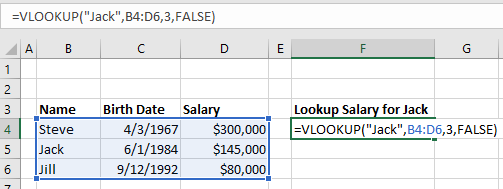
The VLOOKUP and HLOOKUP have two big limitations:
- The lookup column must be the left-most column in the data (or top-most row for a HLOOKUP). Often your data will not come in this format.
- In large workbooks, these lookup functions can take a very long time to run. Ole from Erlandsen Data Consulting says this: A little bit off-topic, but here is a function that I think is sometimes over-used or used in a wrong way: VLOOKUP. This function is extremely useful, but can sometimes cause the calculations in a workbook to slow down to a crawl when used with large data sources and/or in a lot of cells. An example: a workbook that took 5-10 minutes to calculate because of excessive use of the VLOOKUP function, took 7 seconds to calculate after sorting the data sources and replacing VLOOKUP with MATCH and INDEX functions.
NDEX & MATCH
The MATCH function looks up a value in an array of cells and returns the position # where that value is found.
The INDEX function returns a value from an array of cells based on the provided position #.
Together these functions can be used to simulate a VLOOKUP, only with more flexibility. Othniel from Excellent Ones Consulting says this These two functions together are more powerful than the traditional VLOOKUP In a VLOOKUP formula the field to be matched must be in the first column of your data set. Using a combination of Index and match removes those limitation. This adds more flexibility to the user.
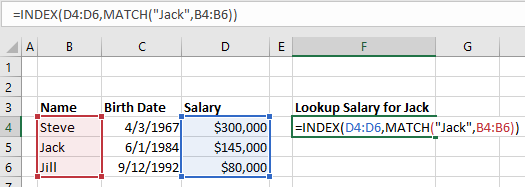
Alan from ComputerGaga notes some other advanced uses of the INDEX function: However other awesome uses include to return the last value from a row or column, to create dynamic ranges and its use with form controls for interactive charts and dashboards.
Match Multiple Criteria with a Formula
These functions also allow you to match multiple criteria. However, the formula is quite complicated!
Marcus Small explains My favourite function to rip out in any of my courses is the combination of INDEX, MATCH, and INDEX. This powerful three part formula allows you to return a match based on multiple criteria. It avoids the concatenation of data with the inevitable use of VLOOKUP and it does not need to be in the form of an array formulation. One caveat, I only use this formula when I am wanting to return TEXT based on multiple criteria, as Excel has SUMIFS and SUMPRODUCT available to deal with multi criteria calculation returns. Quite simply it is formulaic brilliance!!!
The syntax is
Index(result column, match(1, index((criteria range=criteria)*(criteria range2 =criteria2),0),0))
The formula works as it is attempting to match the true condition to the specified criteria. In the above example there is 2 criteria however you could have 3, 4, 5 etc. The secret lies in the 1 part of the MATCH formula. If a match is made in the second INDEX, Excel produces a 1, if no match to the corresponding cell in the second INDEX criteria, Excel produces a zero, so 1 x 0 = 0. Excel continues until 2 matches are made 1 x 1 = 1 and the row where this occurs is then pushed into the first INDEX formula (INDEX(Result Column) to return the value of the row in the result column. It is a marvellous formula which can easily be extended with little effort. Here is 3 criteria:
Index(result column, match(1, index((criteria range=criteria)*(criteria range2 =criteria2)*(criteria range3 =criteria3),0),0))
Now the structure of a file can be preserved without resorting to adding a column to concatenate data so it can be used as LOOKUP criteria.
IFERROR Function — 3 Votes
IFERROR was one of my top choices for the most under-used function in Excel. It’s easy to use, and makes your spreadsheets look much more professional.
Janet from Savvy Spreadsheets describes it’s usefulness: I’ve seen too many reports with ugly # errors in them. The IFERROR function can be wrapped around a formula to quickly and easily hide those errors, by returning something else such as a blank or zero.
If you submit a spreadsheet to a client or superior filled with formula errors, it makes you look bad. Did you even review those errors? Are they valid errors or not? IFERROR makes a huge difference in how the quality of your work is perceived.
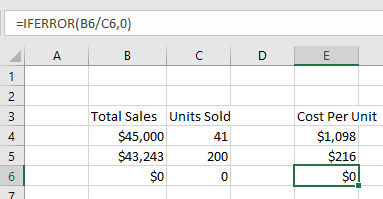
Joe from Excel by Joe describes how to use it: IFERROR is very easy to set up and it can easily eliminate all error messages from your function results. I use it all the time when building spreadsheets. To use it, simply insert whatever function you have written into the first part of the IFERROR and then put a comma and then enter what you want shown if there’s an error. For example, if you want to display a zero whenever your function, A1/A2 has an error, use this code : =IFERROR(A1/A2,0)
Zach from Data Automation Professionals notes that IFERROR was a new function for Excel 2007. Microsoft added this function to save you the hassle of using =IF(ISERROR( and needing to enter the same formula twice.
SUMPRODUCT Function — 3 Votes
The SUMPRODUCT Function sums the products of multiple arrays. The simplest example is calculating total sales revenue based on # of Units Sold and Price per Unit:

SUMPRODUCT can also be used to perform advanced calculations. By creating columns with 1 or 0, you can create «if» conditions where records are only counted if they meet certain criteria (note: multiplying by 0 excludes the record from the SUMPRODUCT, multiplying by 1 includes it). As Ashish says, SUMPRODUCT allows one to specify multiple AND/OR conditions. My Excel Online notes that: this technique is like using SUMIFS on steroids.
Glen from Need a Spreadsheet is right when he says, It takes a while to get your head around SUMPRODUCT, but when you do it gives you enormous power and flexibility.
CONCATENATE, CONCAT, & TEXTJOIN Functions — 2 Votes
Juan from Excel MOOC and Mourad from Excel-Translator voted for CONCATENATE / CONCAT. The CONCATENATE function merges strings of text together. The CONCAT function is a newer version that does the same thing except with a shorter name (less typing the better!). Here is an example of merging text with a space (» «) in between:
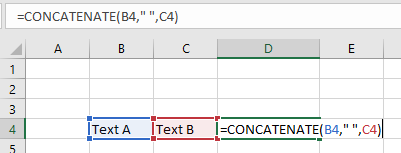
The big downside to CONCATENATE is that you can’t merge an array of cells together. Instead, you must manually select each cell to merge. Microsoft fixed this problem with the new (for Excel 2016) function: TEXTJOIN:
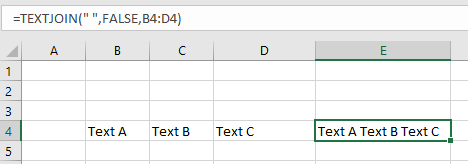
Notice the syntax: First you enter the deliminator (we chose a space » «). Next you enter TRUE/FALSE to decide if blank cells are counted, and last you enter the range to merge.
SIGN Function — 2 Votes
From Amiq Khan’s blog: The Excel SIGN function checks the sign of a number and gives result of 1 if the number is positive, 0 if number is zero and -1 if the number is negative.
When would you use this?
Bill Jelen is a big fan of using the SIGN Function with the Up/Flat/Down icon set:

Bill says: In Row 1, negative numbers like -24 in I1 get an up indicator. Use the SIGN Function to make sure you only get 1,0, or -1 and the icons behave.
SUMIFS & More — 2 Votes
Alex Powers from It’s Not About the Cell and Joseph from Spreadsheets Made Easy both voted for the SUMIFS, COUNTIFS, and, AVERAGEIFS Functions. These functions allow you to perform the desired calculations (sum, count, or average), only on data that meet certain criteria.
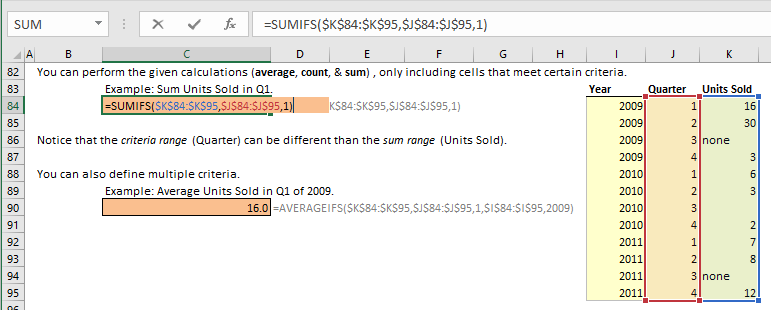
Also, new for Excel 2016 are the MAXIFS and MINIFS Functions (a life-saver for some of the work that I’ve done).
Alex and Joseph also noted that you can transform the basic SUM Function into a much more powerful SUMIFS with the use of «array» functions. Array functions are sometimes referred to as CSE (CTRL + SHIFT + ENTER) functions because when you enter the functions you must type CTRL + SHIFT + ENTER. With array functions, you can perform very complicated calculations, however they can be hard to create (or follow) for all but the most advanced Excel users. With that in mind, we won’t cover an example.
TEXT Function — 2 Votes
The TEXT Function allows you to display a number stored as text in a specified number format.
Brad Edgar described this example: In cell A1 you have the date 04-OCT-2017 and you want to reference that date in a string of text:
=»Today’s date is: » & A1
By default, Excel will show «Today’s date is: 43012» (43012 is the serial number corresponding to that date). Instead, to show the nicely formatted date use the TEXT Function:
=»Today’s date is: » & TEXT(A1,»DD-MMM-YYYY»)

Steve=True from Excel Dashboard Templates had another example:
If you want to display a number with leading zeroes (ex. a ZIP code):

IF and IFS (New for Excel 2016) — 2 Votes
The IF function is ubiquitous in all of coding, as Alex discusses here. It tests if a condition is met. If so, it does something, if not it does something else. You won’t get very far with Excel (or any coding language) without understanding this common function.
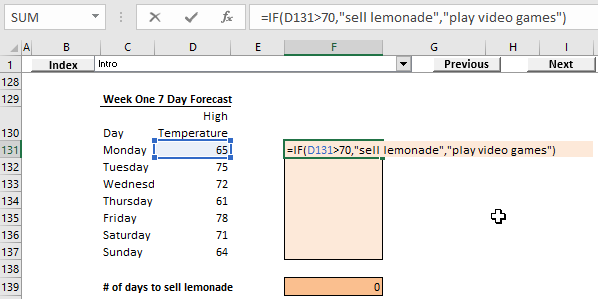
New for Excel 2016, Microsoft released the IFS function. Nick from Excel Spreadsheet Help says: With the IFS function you can now simplify one of the most common uses of the IF function: the dreaded nested IFs. If you use Excel frequently then at some point you’ve probably had to create a crazy long formula with multiple IF functions where it’s difficult to keep track of all the logic and commas. With the release of Excel 2016, the IFS function provides the same results as a nested IF formula but with a much simpler and easy to read method. IFS may be one of the most under-used Excel functions for now because it’s so new, but I think it’s use is going to spread rapidly once Excel users are aware of it existence!
Become an Excel Function Expert
Take our 100% free interactive tutorial on Excel functions. Master the 30 most-used Excel functions!
CONVERT — 2 Votes
From Charlie at Engineer Excel: CONVERT is a really efficient way to convert many different quantities like length, mass, volume, etc. between different sets of units. I find that many people (myself included before I found this function) «hard code» numbers into their spreadsheets in order to convert between unit systems. The CONVERT function eliminates the need to do that.
Kawser from Exceldemy provides a good example: Say I want to convert 100 Tones to Stones. See the image below.
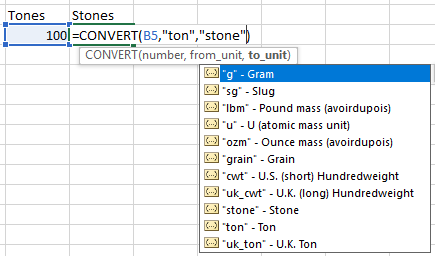
It’s easy to convert almost any unit to other relevant unit using this Excel function.
SUBTOTAL Function — 1 Votes
Ben from Excel Exposure voted for the SUBTOTAL function saying: People generally don’t know what it does, or how to use it. Even while praising it now myself, I realize I don’t use it enough.
The SUBTOTAL Functions allows you to perform different calculations on a data set. You can see the list of options when you enter the function into Excel:
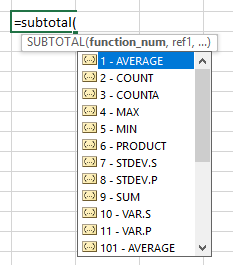
You might be asking yourself, why wouldn’t you just use the AVERAGE function if you want to average or the COUNT function if you want to count?
You would use SUBTOTAL when you might change which calculation you wish to view. For example, you create a summary sheet to summarize a very large data set. You create a drop-down to select what information to show. Without using the SUBTOTAL function, you would need to create each calculation individually, and the drop-down would select which to show. With SUBTOTAL, you can create one formula that reads the drop-down and performs the appropriate calculation.
The SUBTOTAL function can reduce your calculation speed and reduce the number of formulas needed.
DOLLARDE and DOLLARFR — 1 Votes
Vijay from E for Excel says: Though designed as financial functions, these perform great conversion routines. I, very often, use them for time to decimal conversions. For example, 1:30 hours is 1.5 hours in decimal.
=DOLLARDE(1.30,60)
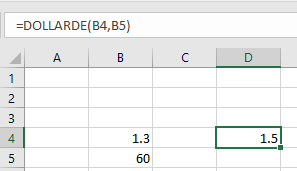
To convert it back to 1:30
=DOLLARFR(1.5,60)
(Note, it converts decimals not time value i.e. why 1.3 has been used to convert into 1.5. Though the same you can achieve through multiplying by 24 in case of DOLLARDE and divide by 24 for DOLLARFR. Hence 1:30/24 will give 1.5 and 1.5/24 will give 1:30)
The impact is even more strong once you perform other odd conversions
Convert 6 feet 6 inches
=DOLLARDE(6.06,12)
Which is 6.5 i.e. 6 and half feet
Similarily 6.3 is 6.5 dozen if =DOLLARDE(6.5,6) i.e. 6 and half dozen
So, you can perform many odd conversions which can not be done by CONVERT function.
Date Functions — 1 `Votes
Erin from Time Saving Templates suggested the date functions: DAY, MONTH, and YEAR. These functions extract the day, month, or year number from a date. If you work with dates you should know and use these (easy to remember) functions.
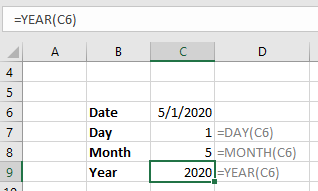
I also recommend the EDATE, EOMONTH, and DATE Functions. EDATE and EOMONTH roll dates forward or back a number of months (EOMONTH then returns the last day of that month). DATE is used to create a date from a given day, month or, year.
When entering dates into Excel, use one input cell to provide the starting date or year, and calculate all other dates using these functions. This makes updating spreadsheets monthly or annually a breeze! No more manually editing hard-coded dates!
MMULT Function — 1 `Votes
Earlier we mentioned the SUMPRODUCT function. SUMPRODUCT allows you to sum the products of multiple arrays. The MMULT function can be used in a similar way. Oscar from Get Digital Help says MMULT allows you to do calculations like the SUMPRODUCT function but in a more granular way. SUMPRODUCT lets you multiply and then sum arrays, whereas the MMULT function lets you multiply and sum arrays row-wise or column-wise.
MMULT stands for Matrix Multiplication. If you have a strong math background, you’ll know exactly what it does:
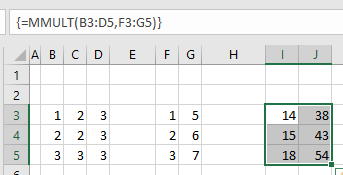
It’s also an Array function (notice the brackets surrounding the formula above), which means you must use CTRL + SHIFT + ENTER when entering the formula.
INDIRECT Function — 1 `Votes
Abhilash from Excel to XL recommended the INDIRECT function. The INDIRECT Function allows you to «indirectly» reference cell ranges by treating the cell range as text.
To reference cell A1:
=INDIRECT(«A1»)
This is useful when you want to use formulas to determine which cell to reference. So instead of hard-coding «A1» into the formula above, you could reference a cell with formulas that output «A1», «B2», etc. This can be VERY useful when your desired ranges are on different worksheets.
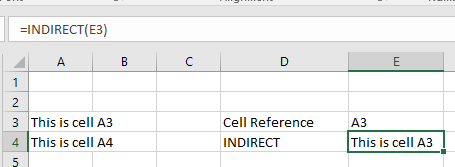
Warning: INDIRECT is a «volatile» function, meaning it re-calculates every time Excel recalculates the workbook. They won’t slow your workbook down if you use a small number of them, but if you have large blocks of INDIRECT functions, you may start to notice a lag.
Often, you can avoid INDIRECTs with smart use of the CHOOSE and INDEX functions (see above).
LEN Function — 1 `Votes
The LEN Function counts the number of characters in a string of text. LEN can be useful when using other text functions such as LEFT, RIGHT, or MID.
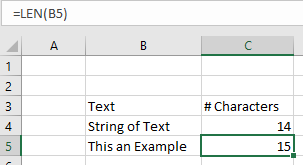
Onur from Someka.net makes an outstanding point about using LEN to check for blank cells: LEN is the most reliable way to check blank cells.
Some of you may ask: «Hey, I use =IF(A1=»»,…) method for checking blank cells, why would I need the LEN function? Aren’t they the same?»
I prefer to use LEN for two reasons:
- When you copy and paste from other applications (word, access) blank cells are not counted as «real blank cells». (read more)
- Sometimes people enter space, line break, dot, or something similar to a blank cell, whether intentionally or accidentally. The workbooks need to account for this as well.
For these reasons to be on the very safe side I prefer to use LEN. In most cases, =IF(A1=»»,…) will do the work though.
OFFSET Function — 1 `Votes
Ismael from Excelforo voted for the OFFSET function. With the OFFSET function, you reference a cell by «offsetting» a certain number of rows and columns from a starting point. You can also resize the cell range to any number of rows and columns.
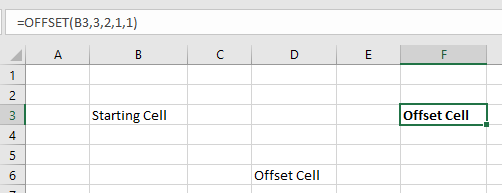
I’ve found the OFFSET function be extremely useful when coupled with VBA code that inserts and deletes rows and columns. By using the OFFSET, you can avoid #REF errors that appear when referenced cells are deleted.
Note: OFFSET is a «volatile function». Volatile functions recalculate each time Excel recalculates. If you have too many OFFSET functions, your workbook will slow down.
REPT Function — 1 `Votes
The REPT function allows you to repeat a string of text a certain number of times:
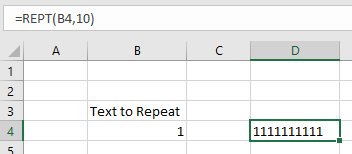
The true value of this function, however, lies in more creative uses as Crispo from CrispExcel points out: Although classified as a text function, REPT function does more than just repeating texts a number of times. For example, REPT is a perfect alternative to the slow calculating and complex Nested IF function. This is because REPT function can also act as a Logical Function returning an empty string if the number to return is zero. This ability to return an empty string makes it a perfect function for leaving comments within a cell instead of using N function.
REPT‘s ability to repeat characters also makes it perfect to create Mirror Charts (see below), Inline charts, Stem & Leaf Plots, Sparkline, star rating template and even the elusive FOMC dot plot chart.
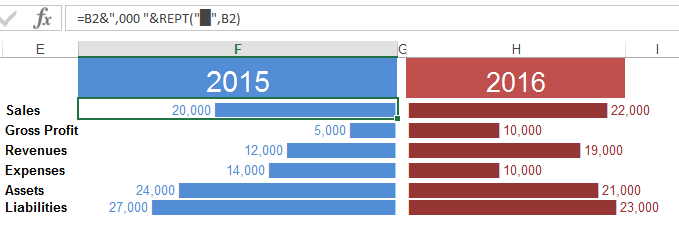
CELL & GET Functions — 1 `Votes
The team at Spreadsheet Detective suggested the GET & CELL functions. The GET function is an old XL4 function that can’t be used in the same way as a normal Excel function. If you’re interested in using this function, here is more information (warning: It’s complicated).
The function can return useful information about a cell: color, row height, and much more. However, all of this can also be accomplished using VBA or some of the functionality can be accomplished with the newer CELL function.
The CELL function can return the following information about a cell:
Simply define the information you want to see and which cell you want to test!
MOD Function — 1 `Votes
The MOD function returns the remainder of two numbers after division. Why is this useful? You can easily determine odd or even numbered rows (for alternate row shading) and, more generally, split data into separate groups.
Jorge from Power Spreadsheets says: The main reason I find MOD useful is because of how it allows you to break a group of items into different groups. I commonly use MOD in 2 contexts: (i) in conditional formatting formulas, such as formatting alternate rows or columns; or (ii) to classify entries or values into different groups, which allows you to work with subsets or them (for example, working with odd or even numbers, or entries located every nth cell).
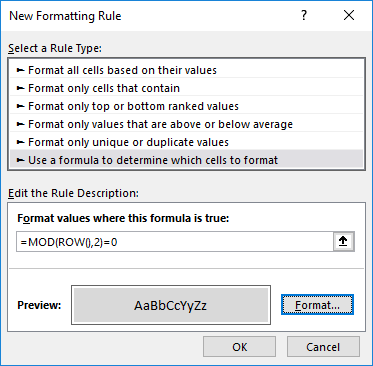
GETPIVOTDATA — 1 `Votes
Debra from Contextures.com recommended the GETPIVOTDATA function: A GETPIVOTDATA formula is automatically created if you link to a PivotTable Value cell. Don’t turn that feature off! Learn how to tweak the formula, so it will pull out the pivot table data that you need.
Her site has an excellent page on the GETPIVOTDATA Function. Visit it to learn more.

User-Defined Functions — 1 `Votes
User-Defined Functions (UDFs) are custom functions created in VBA. If Excel doesn’t have a function that you need, you can create your own in VBA. Obviously, VBA isn’t for everyone, but if you are familiar with VBA, you might want to keep UDFs in mind. Jon from Vertex42 talks about UDFs: I think that custom user-defined functions may be underutilized. While there are many reasons why you might not want to use VBA within a spreadsheet, it is pretty simple to create your own add-in and populate it with custom functions that help speed up what you do in Excel. I avoid using custom functions in spreadsheets that I share with other people, but there are many custom functions that I use that allow me to easily do things I might not otherwise be able to do. Using the VB date functions to work with dates prior to 1900 is an example.
Text to Columns — 1 `Votes
Text to Columns isn’t an Excel function, but it is a very powerful Excel tool that can be used instead of using Excel text functions. The team at TestsTestsTests.com says this: Excel users (that don’t know better) can spend hours manually separating and moving data from a single column to adjacent columns using copy/cut and paste or Excel text functions like LEFT, RIGHT, MID, etc.. A column may contain names, surnames, and/or dates of births that needs to be separated. A surprisingly quick and easy way of doing this is to use Text to Columns located in the Data Tools group under the Data tab of the Excel Ribbon. Text to Columns provides multiple options to separate the data, including by delimiters such as spaces or commas, or by a fixed width, allowing you to separate the data visually. This tool becomes especially useful when data is copied and pasted from other applications, such as tables in Microsoft Word, .csv (comma separated values) files, and more.
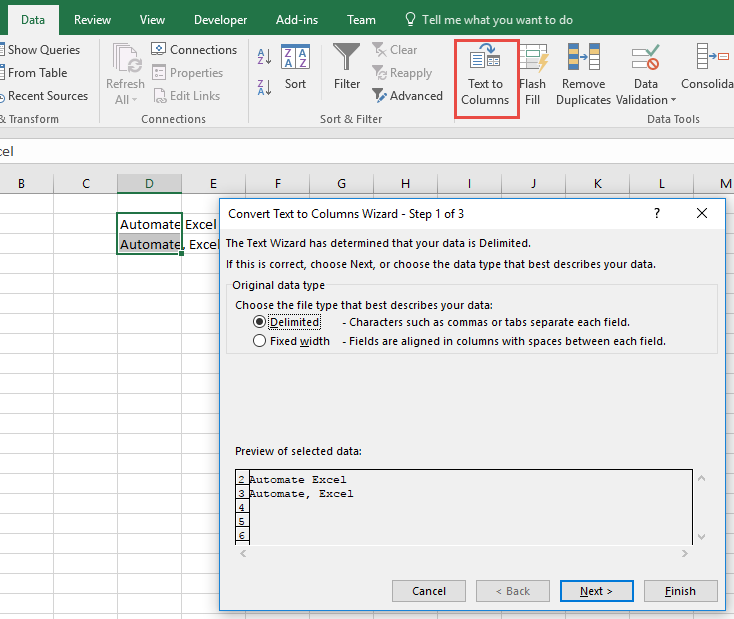
Flash Fill — 1 `Votes
Just like Text to Columns, Flash Fill isn’t an Excel function, but it is an under-used feature of Excel that can help alleviate the need for complex Excel formulas. The team over at Yoda Learning said this: Simply enter a pattern in the first several cells. Go to Data > Flash Fill (CTRL + E) and Excel will calculate the algorithm for the rest of the column.
Note: Generally, you would use this when you have a column of fully-populated data and you would like to create a second column based off of the first. For example, in the second column you would like to add «test» in front of the text from the first column. Instead of creating a formula to do so, you would manually enter the values in and then go to Flash Fill to populate the rest of the column.
You might notice that Excel suggests this automatically for you. In the Options menu you can toggle whether automatic Flash Fill is enabled or not.
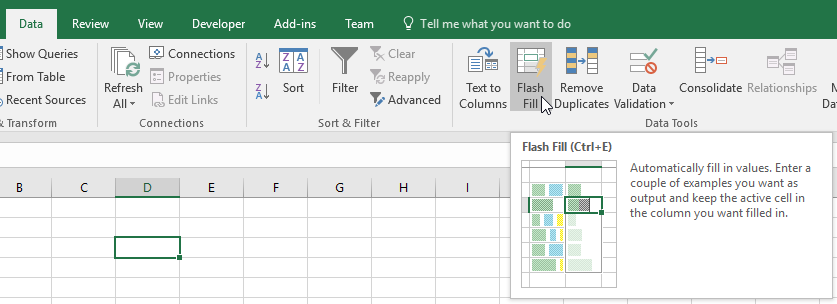
Become an Excel Function Expert
Take our 100% free interactive tutorial on Excel functions. Master the 30 most-used Excel functions!
Below is a brief overview of about 100 important Excel functions you should know, with links to detailed examples. We also have a large list of example formulas, a more complete list of Excel functions, and video training. If you are new to Excel formulas, see this introduction.
Note: Excel now includes Dynamic Array formulas, which offer important new functions.
Date and Time Functions
Excel provides many functions to work with dates and times.
NOW and TODAY
You can get the current date with the TODAY function and the current date and time with the NOW Function. Technically, the NOW function returns the current date and time, but you can format as time only, as seen below:
TODAY() // returns current date
NOW() // returns current time
Note: these are volatile functions and will recalculate with every worksheet change. If you want a static value, use date and time shortcuts.
DAY, MONTH, YEAR, and DATE
You can use the DAY, MONTH, and YEAR functions to disassemble any date into its raw components, and the DATE function to put things back together again.
=DAY("14-Nov-2018") // returns 14
=MONTH("14-Nov-2018") // returns 11
=YEAR("14-Nov-2018") // returns 2018
=DATE(2018,11,14) // returns 14-Nov-2018
HOUR, MINUTE, SECOND, and TIME
Excel provides a set of parallel functions for times. You can use the HOUR, MINUTE, and SECOND functions to extract pieces of a time, and you can assemble a TIME from individual components with the TIME function.
=HOUR("10:30") // returns 10
=MINUTE("10:30") // returns 30
=SECOND("10:30") // returns 0
=TIME(10,30,0) // returns 10:30
DATEDIF and YEARFRAC
You can use the DATEDIF function to get time between dates in years, months, or days. DATEDIF can also be configured to get total time in «normalized» denominations, i.e. «2 years and 6 months and 27 days».
Use YEARFRAC to get fractional years:
=YEARFRAC("14-Nov-2018","10-Jun-2021") // returns 2.57
EDATE and EOMONTH
A common task with dates is to shift a date forward (or backward) by a given number of months. You can use the EDATE and EOMONTH functions for this. EDATE moves by month and retains the day. EOMONTH works the same way, but always returns the last day of the month.
EDATE(date,6) // 6 months forward
EOMONTH(date,6) // 6 months forward (end of month)
WORKDAY and NETWORKDAYS
To figure out a date n working days in the future, you can use the WORKDAY function. To calculate the number of workdays between two dates, you can use NETWORKDAYS.
WORKDAY(start,n,holidays) // date n workdays in future
Video: How to calculate due dates with WORKDAY
NETWORKDAYS(start,end,holidays) // number of workdays between dates
Note: Both functions automatically skip weekends (Saturday and Sunday) and will also skip holidays, if provided. If you need more flexibility on what days are considered weekends, see the WORKDAY.INTL function and NETWORKDAYS.INTL function.
WEEKDAY and WEEKNUM
To figure out the day of week from a date, Excel provides the WEEKDAY function. WEEKDAY returns a number between 1-7 that indicates Sunday, Monday, Tuesday, etc. Use the WEEKNUM function to get the week number in a given year.
=WEEKDAY(date) // returns a number 1-7
=WEEKNUM(date) // returns week number in year
Engineering
CONVERT
Most Engineering functions are pretty technical…you’ll find a lot of functions for complex numbers in this section. However, the CONVERT function is quite useful for everyday unit conversions. You can use CONVERT to change units for distance, weight, temperature, and much more.
=CONVERT(72,"F","C") // returns 22.2
Information Functions
ISBLANK, ISERROR, ISNUMBER, and ISFORMULA
Excel provides many functions for checking the value in a cell, including ISNUMBER, ISTEXT, ISLOGICAL, ISBLANK, ISERROR, and ISFORMULA These functions are sometimes called the «IS» functions, and they all return TRUE or FALSE based on a cell’s contents.
Excel also has ISODD and ISEVEN functions that will test a number to see if it’s even or odd.
By the way, the green fill in the screenshot above is applied automatically with a conditional formatting formula.
Logical Functions
Excel’s logical functions are a key building block of many advanced formulas. Logical functions return the boolean values TRUE or FALSE. If you need a primer on logical formulas, this video goes through many examples.
AND, OR and NOT
The core of Excel’s logical functions are the AND function, the OR function, and the NOT function. In the screen below, each of these function is used to run a simple test on the values in column B:
=AND(B5>3,B5<9)
=OR(B5=3,B5=9)
=NOT(B5=2)
- Video: How to build logical formulas
- Guide: 50 examples of formula criteria
IFERROR and IFNA
The IFERROR function and IFNA function can be used as a simple way to trap and handle errors. In the screen below, VLOOKUP is used to retrieve cost from a menu item. Column F contains just a VLOOKUP function, with no error handling. Column G shows how to use IFNA with VLOOKUP to display a custom message when an unrecognized item is entered.
=VLOOKUP(E5,menu,2,0) // no error trapping
=IFNA(VLOOKUP(E5,menu,2,0),"Not found") // catch errors
Whereas IFNA only catches an #N/A error, the IFERROR function will catch any formula error.
IF and IFS functions
The IF function is one of the most used functions in Excel. In the screen below, IF checks test scores and assigns «pass» or «fail»:
Multiple IF functions can be nested together to perform more complex logical tests.
New in Excel 2019 and Excel 365, the IFS function can run multiple logical tests without nesting IFs.
=IFS(C5<60,"F",C5<70,"D",C5<80,"C",C5<90,"B",C5>=90,"A")
Lookup and Reference Functions
VLOOKUP and HLOOKUP
Excel offers a number of functions to lookup and retrieve data. Most famous of all is VLOOKUP:
=VLOOKUP(C5,$F$5:$G$7,2,TRUE)
More: 23 things to know about VLOOKUP.
HLOOKUP works like VLOOKUP, but expects data arranged horizontally:
=HLOOKUP(C5,$G$4:$I$5,2,TRUE)
INDEX and MATCH
For more complicated lookups, INDEX and MATCH offers more flexibility and power:
=INDEX(C5:E12,MATCH(H4,B5:B12,0),MATCH(H5,C4:E4,0))
Both the INDEX function and the MATCH function are powerhouse functions that turn up in all kinds of formulas.
More: How to use INDEX and MATCH
LOOKUP
The LOOKUP function has default behaviors that make it useful when solving certain problems. LOOKUP assumes values are sorted in ascending order and always performs an approximate match. When LOOKUP can’t find a match, it will match the next smallest value. In the example below we are using LOOKUP to find the last entry in a column:
ROW and COLUMN
You can use the ROW function and COLUMN function to find row and column numbers on a worksheet. Notice both ROW and COLUMN return values for the current cell if no reference is supplied:
The row function also shows up often in advanced formulas that process data with relative row numbers.
ROWS and COLUMNS
The ROWS function and COLUMNS function provide a count of rows in a reference. In the screen below, we are counting rows and columns in an Excel Table named «Table1».
Note ROWS returns a count of data rows in a table, excluding the header row. By the way, here are 23 things to know about Excel Tables.
HYPERLINK
You can use the HYPERLINK function to construct a link with a formula. Note HYPERLINK lets you build both external links and internal links:
=HYPERLINK(C5,B5)
GETPIVOTDATA
The GETPIVOTDATA function is useful for retrieving information from existing pivot tables.
=GETPIVOTDATA("Sales",$B$4,"Region",I6,"Product",I7)
CHOOSE
The CHOOSE function is handy any time you need to make a choice based on a number:
=CHOOSE(2,"red","blue","green") // returns "blue"
Video: How to use the CHOOSE function
TRANSPOSE
The TRANSPOSE function gives you an easy way to transpose vertical data to horizontal, and vice versa.
{=TRANSPOSE(B4:C9)}
Note: TRANSPOSE is a formula and is, therefore, dynamic. If you just need to do a one-time transpose operation, use Paste Special instead.
OFFSET
The OFFSET function is useful for all kinds of dynamic ranges. From a starting location, it lets you specify row and column offsets, and also the final row and column size. The result is a range that can respond dynamically to changing conditions and inputs. You can feed this range to other functions, as in the screen below, where OFFSET builds a range that is fed to the SUM function:
=SUM(OFFSET(B4,1,I4,4,1)) // sum of Q3
INDIRECT
The INDIRECT function allows you to build references as text. This concept is a bit tricky to understand at first, but it can be useful in many situations. Below, we are using INDIRECT to get values from cell A1 in 5 different worksheets. Each reference is dynamic. If a sheet name changes, the reference will update.
=INDIRECT(B5&"!A1") // =Sheet1!A1
The INDIRECT function is also used to «lock» references so they won’t change, when rows or columns are added or deleted. For more details, see linked examples at the bottom of the INDIRECT function page.
Caution: both OFFSET and INDIRECT are volatile functions and can slow down large or complicated spreadsheets.
STATISTICAL Functions
COUNT and COUNTA
You can count numbers with the COUNT function and non-empty cells with COUNTA. You can count blank cells with COUNTBLANK, but in the screen below we are counting blank cells with COUNTIF, which is more generally useful.
=COUNT(B5:F5) // count numbers
=COUNTA(B5:F5) // count numbers and text
=COUNTIF(B5:F5,"") // count blanks
COUNTIF and COUNTIFS
For conditional counts, the COUNTIF function can apply one criteria. The COUNTIFS function can apply multiple criteria at the same time:
=COUNTIF(C5:C12,"red") // count red
=COUNTIF(F5:F12,">50") // count total > 50
=COUNTIFS(C5:C12,"red",D5:D12,"TX") // red and tx
=COUNTIFS(C5:C12,"blue",F5:F12,">50") // blue > 50
Video: How to use the COUNTIF function
SUM, SUMIF, SUMIFS
To sum everything, use the SUM function. To sum conditionally, use SUMIF or SUMIFS. Following the same pattern as the counting functions, the SUMIF function can apply only one criteria while the SUMIFS function can apply multiple criteria.
=SUM(F5:F12) // everything
=SUMIF(C5:C12,"red",F5:F12) // red only
=SUMIF(F5:F12,">50") // over 50
=SUMIFS(F5:F12,C5:C12,"red",D5:D12,"tx") // red & tx
=SUMIFS(F5:F12,C5:C12,"blue",F5:F12,">50") // blue & >50
Video: How to use the SUMIF function
AVERAGE, AVERAGEIF, and AVERAGEIFS
Following the same pattern, you can calculate an average with AVERAGE, AVERAGEIF, and AVERAGEIFS.
=AVERAGE(F5:F12) // all
=AVERAGEIF(C5:C12,"red",F5:F12) // red only
=AVERAGEIFS(F5:F12,C5:C12,"red",D5:D12,"tx") // red and tx
MIN, MAX, LARGE, SMALL
You can find largest and smallest values with MAX and MIN, and nth largest and smallest values with LARGE and SMALL. In the screen below, data is the named range C5:C13, used in all formulas.
=MAX(data) // largest
=MIN(data) // smallest
=LARGE(data,1) // 1st largest
=LARGE(data,2) // 2nd largest
=LARGE(data,3) // 3rd largest
=SMALL(data,1) // 1st smallest
=SMALL(data,2) // 2nd smallest
=SMALL(data,3) // 3rd smallest
Video: How to find the nth smallest or largest value
MINIFS, MAXIFS
The MINIFS and MAXIFS. These functions let you find minimum and maximum values with conditions:
=MAXIFS(D5:D15,C5:C15,"female") // highest female
=MAXIFS(D5:D15,C5:C15,"male") // highest male
=MINIFS(D5:D15,C5:C15,"female") // lowest female
=MINIFS(D5:D15,C5:C15,"male") // lowest male
Note: MINIFS and MAXIFS are new in Excel via Office 365 and Excel 2019.
MODE
The MODE function returns the most commonly occurring number in a range:
=MODE(B5:G5) // returns 1
RANK
To rank values largest to smallest, or smallest to largest, use the RANK function:
Video: How to rank values with the RANK function
MATH Functions
ABS
To change negative values to positive use the ABS function.
=ABS(-134.50) // returns 134.50
RAND and RANDBETWEEN
Both the RAND function and RANDBETWEEN function can generate random numbers on the fly. RAND creates long decimal numbers between zero and 1. RANDBETWEEN generates random integers between two given numbers.
=RAND() // between zero and 1
=RANDBETWEEN(1,100) // between 1 and 100
ROUND, ROUNDUP, ROUNDDOWN, INT
To round values up or down, use the ROUND function. To force rounding up to a given number of digits, use ROUNDUP. To force rounding down, use ROUNDDOWN. To discard the decimal part of a number altogether, use the INT function.
=ROUND(11.777,1) // returns 11.8
=ROUNDUP(11.777) // returns 11.8
=ROUNDDOWN(11.777,1) // returns 11.7
=INT(11.777) // returns 11
MROUND, CEILING, FLOOR
To round values to the nearest multiple use the MROUND function. The FLOOR function and CEILING function also round to a given multiple. FLOOR forces rounding down, and CEILING forces rounding up.
=MROUND(13.85,.25) // returns 13.75
=CEILING(13.85,.25) // returns 14
=FLOOR(13.85,.25) // returns 13.75
MOD
The MOD function returns the remainder after division. This sounds boring and geeky, but MOD turns up in all kinds of formulas, especially formulas that need to do something «every nth time». In the screen below, you can see how MOD returns zero every third number when the divisor is 3:
SUMPRODUCT
The SUMPRODUCT function is a powerful and versatile tool when dealing with all kinds of data. You can use SUMPRODUCT to easily count and sum based on criteria, and you can use it in elegant ways that just don’t work with COUNTIFS and SUMIFS. In the screen below, we are using SUMPRODUCT to count and sum orders in March. See the SUMPRODUCT page for details and links to many examples.
=SUMPRODUCT(--(MONTH(B5:B12)=3)) // count March
=SUMPRODUCT(--(MONTH(B5:B12)=3),C5:C12) // sum March
SUBTOTAL
The SUBTOTAL function is an «aggregate function» that can perform a number of operations on a set of data. All told, SUBTOTAL can perform 11 operations, including SUM, AVERAGE, COUNT, MAX, MIN, etc. (see this page for the full list). The key feature of SUBTOTAL is that it will ignore rows that have been «filtered out» of an Excel Table, and, optionally, rows that have been manually hidden. In the screen below, SUBTOTAL is used to count and sum only the 7 visible rows in the table:
=SUBTOTAL(3,B5:B14) // returns 7
=SUBTOTAL(9,F5:F14) // returns 9.54
AGGREGATE
Like SUBTOTAL, the AGGREGATE function can also run a number of aggregate operations on a set of data and can optionally ignore hidden rows. The key differences are that AGGREGATE can run more operations (19 total) and can also ignore errors.
In the screen below, AGGREGATE is used to perform MIN, MAX, LARGE and SMALL operations while ignoring errors. Normally, the error in cell B9 would prevent these functions from returning a result. See this page for a full list of operations AGGREGATE can perform.
=AGGREGATE(4,6,values) // MAX ignore errors, returns 100
=AGGREGATE(5,6,values) // MIN ignore errors, returns 75
TEXT Functions
LEFT, RIGHT, MID
To extract characters from the left, right, or middle of text, use LEFT, RIGHT, and MID functions:
=LEFT("ABC-1234-RED",3) // returns "ABC"
=MID("ABC-1234-RED",5,4) // returns "1234"
=RIGHT("ABC-1234-RED",3) // returns "RED"
LEN
The LEN function will return the length of a text string. LEN shows up in a lot of formulas that count words or characters.
FIND, SEARCH
To look for specific text in a cell, use the FIND function or SEARCH function. These functions return the numeric position of matching text, but SEARCH allows wildcards and FIND is case-sensitive. Both functions will throw an error when text is not found, so wrap in the ISNUMBER function to return TRUE or FALSE (example here).
=FIND("Better the devil you know","devil") // returns 12
=SEARCH("This is not my beautiful wife","bea*") // returns 12
REPLACE, SUBSTITUTE
To replace text by position, use the REPLACE function. To replace text by matching, use the SUBSTITUTE function. In the first example, REPLACE removes the two asterisks (**) by replacing the first two characters with an empty string («»). In the second example, SUBSTITUTE removes all hash characters (#) by replacing «#» with «».
=REPLACE("**Red",1,2,"") // returns "Red"
=SUBSTITUTE("##Red##","#","") // returns "Red"
CODE, CHAR
To figure out the numeric code for a character, use the CODE function. To translate the numeric code back to a character, use the CHAR function. In the example below, CODE translates each character in column B to its corresponding code. In column F, CHAR translates the code back to a character.
=CODE("a") // returns 97
=CHAR(97) // returns "a"
Video: How to use the CODE and CHAR functions
TRIM, CLEAN
To get rid of extra space in text, use the TRIM function. To remove line breaks and other non-printing characters, use CLEAN.
=TRIM(A1) // remove extra space
=CLEAN(A1) // remove line breaks
Video: How to clean text with TRIM and CLEAN
CONCAT, TEXTJOIN, CONCATENATE
New in Excel via Office 365 are CONCAT and TEXTJOIN. The CONCAT function lets you concatenate (join) multiple values, including a range of values without a delimiter. The TEXTJOIN function does the same thing, but allows you to specify a delimiter and can also ignore empty values.
=TEXTJOIN(",",TRUE,B4:H4) // returns "red,blue,green,pink,black"
=CONCAT(B7:H7) // returns "8675309"
Excel also provides the CONCATENATE function, but it doesn’t offer special features. I wouldn’t bother with it and would instead concatenate directly with the ampersand (&) character in a formula.
EXACT
The EXACT function allows you to compare two text strings in a case-sensitive manner.
UPPER, LOWER, PROPER
To change the case of text, use the UPPER, LOWER, and PROPER function
=UPPER("Sue BROWN") // returns "SUE BROWN"
=LOWER("Sue BROWN") // returns "sue brown"
=PROPER("Sue BROWN") // returns "Sue Brown"
Video: How to change case with formulas
TEXT
Last but definitely not least is the TEXT function. The text function lets you apply number formatting to numbers (including dates, times, etc.) as text. This is especially useful when you need to embed a formatted number in a message, like «Sale ends on [date]».
=TEXT(B5,"$#,##0.00")
=TEXT(B6,"000000")
="Save "&TEXT(B7,"0%")
="Sale ends "&TEXT(B8,"mmm d")
More: Detailed examples of custom number formatting.
Dynamic Array functions
Dynamic arrays are new in Excel 365, and are a major upgrade to Excel’s formula engine. As part of the dynamic array update, Excel includes new functions which directly leverage dynamic arrays to solve problems that are traditionally hard to solve with conventional formulas. If you are using Excel 365, make sure you are aware of these new functions:
| Function | Purpose |
|---|---|
| FILTER | Filter data and return matching records |
| RANDARRAY | Generate array of random numbers |
| SEQUENCE | Generate array of sequential numbers |
| SORT | Sort range by column |
| SORTBY | Sort range by another range or array |
| UNIQUE | Extract unique values from a list or range |
| XLOOKUP | Modern replacement for VLOOKUP |
| XMATCH | Modern replacement for the MATCH function |
Video: New dynamic array functions in Excel (about 3 minutes).
Quick navigation
ABS, AGGREGATE, AND, AVERAGE, AVERAGEIF, AVERAGEIFS, CEILING, CHAR, CHOOSE, CLEAN, CODE, COLUMN, COLUMNS, CONCAT, CONCATENATE, CONVERT, COUNT, COUNTA, COUNTBLANK, COUNTIF, COUNTIFS, DATE, DATEDIF, DAY, EDATE, EOMONTH, EXACT, FIND, FLOOR, GETPIVOTDATA, HLOOKUP, HOUR, HYPERLINK, IF, IFERROR, IFNA, IFS, INDEX, INDIRECT, INT, ISBLANK, ISERROR, ISEVEN, ISFORMULA, ISLOGICAL, ISNUMBER, ISODD, ISTEXT, LARGE, LEFT, LEN, LOOKUP, LOWER, MATCH, MAX, MAXIFS, MID, MIN, MINIFS, MINUTE, MOD, MODE, MONTH, MROUND, NETWORKDAYS, NOT, NOW, OFFSET, OR, PROPER, RAND, RANDBETWEEN, RANK, REPLACE, RIGHT, ROUND, ROUNDDOWN, ROUNDUP, ROW, ROWS, SEARCH, SECOND, SMALL, SUBSTITUTE, SUBTOTAL, SUM, SUMIF, SUMIFS, SUMPRODUCT, TEXT, TEXTJOIN, TIME, TODAY, TRANSPOSE, TRIM, UPPER, VLOOKUP, WEEKDAY, WEEKNUM, WORKDAY, YEAR, YEARFRAC
Содержание
- Atanas Yonkov Blogger, Web Developer yonkov.atanas@gmail.com
- 1. Sum
- 2. Average
- 4. Sumif
- 5. Countif
- 6. Counta
- 7. Vlookup
- 8. Left, Right, Mid
- 9. Trim
- 10. Concatenate
- 11. Len
- 12. Max
- 13. Min
- 14. Days
- 15. Networkdays
- 16. SQRT
- 17. Now
- 18. Round
- 19.Roundup
- 20. Rounddown
- Most Used Functions
- 1. COUNT
- 2. SUM
- 4. AVERAGE
- 5. COUNTIF
- 6. SUMIF
- 7. VLOOKUP
- 8. MIN
- 9. MAX
- 10. SUMPRODUCT
- 12 Most Useful Excel Functions for Data Analysis
- Join the Excel conversation on Slack
- Download your free practice workbook
- 2. SUMIFS
- 3. COUNTIFS
- 4. TRIM
- 5. CONCATENATE
- 6. LEFT/RIGHT
- 7. VLOOKUP
- 8. IFERROR
- 9. VALUE
- 10. UNIQUE
- 11. SORT
- 12. FILTER
- Wrap Up
 Atanas Yonkov Blogger, Web Developer
Atanas Yonkov Blogger, Web Developer
yonkov.atanas@gmail.com
MS Excel is one of the most popular data analysis tools in the world. More and more companies greatly depend on this software and quite a lot of people are using it on a daily basis. However, from my experience, not many are taking full advantage of the opportunities that the program can offer. Here is my list of the top 20 most important and useful Excel functions, which everyone should use in order to increase his efficiency. Excel functions are also highly recommended over manual calculations, as they can greatly reduce the number of errors. Last but not least, learning these formulas is a wonderful opportunity for you to improve your Excel knowledge and become a confident MS Excel user.
Table of Contents
1. Sum
“Sum” is probably the easiest and the most important Excel function at the same time. You can use it to calculate sum of a range of cells.
In this example, the first formula sums the cells from A1 to A10. The second sums only cells A1 and A10. You can play around with it and try to use different ranges in order to get used to it. Please note that you can also use specific values inside the function, instead of references.
2. Average
Another very important function. As the name suggests, this formula estimates the average number from a range of cells. Suppose that we have a range of values in column A.
This will return the average value of the cells from A1 to A10.
Another must-use formula. It is relatively easy to use and very powerful at the same time. You can use this function to check whether a statement is true or false and return the stated value.
Here, the formula looks for sales over 100 € in cell “A2”. If this statement is true, the formula returns “yes”. If the sales are below 100 €, the formula returns “no”.
4. Sumif
Sumif is another very useful Excel formula. The formula will sum values, if a certain condition is met.
Let’s have a look at the above example. We have sales agents who register a certain number of sales. We want to know the total number of sales for each agent. The function = SUMIF (A1: A20, A2, B1: B20) sums the values of cells B1: B20 that correspond to the text in cell A2 (in the case of Ivailo). The guy has registered a total sales of 325 €. We can use the formula to calculate the turnover of the other agents as well.
5. Countif
Countif is a very useful function that works like a sumif. It sums under a certain condition. The difference between sum and count is that the count function counts the number of cells where certain condition is true. On the contrary, the sumif function sums the values inside the cells.
The formula in the above example checks how many times sales are made over 100 € and returns the number of occurances. You can also include more than one criteria by using countifs for that purpose.
PS: If you are not sure about the syntax of a function, you can always use the Insert function option in Excel (Just press the function sign on the left side of the function bar). In the next example, we will demonstrate how this works.
6. Counta
This formula counts the number of cells from a specific range which are not empty. It is very useful when you have thousands of rows and you want to know where this all ends. Example 6.
This will give you the number of rows that contain value, text or any other symbol.
7. Vlookup
Probably the most powerful Excel function. Very useful when you have to deal with more than one table, different sheets or even a different workbook. Vlookup lets you exract data from one table to another.
Let’s continue with the above example by adding another column “A” with customer numbers.
Note that there is information about the sales and the customer numbers, but the customers’ names are missing. However, we have another Excel sheet (Sheet2) with client names and client numbers.
Instead of taking our time to look from Sheet1 to Sheet2 and search for a match manually for each single row, we should use the following formula:
This formula looks up for the value in cell A2 (112 in our case) in sheet2, columns A & B (the “$” signs mean that we want to have a constant lookup range). The function then returns the value from the second column. The last part of the formula is 0. In this way we tell Excel to look for a match in a shuffle order, not only in one row.
Now, try to construct your own vlookup formula using the insert formula option.
In our case, it looks like this:
8. Left, Right, Mid
The left, right and mid functions are very important functions that allow you to extract a definite number of symbols from a string
In our example, with the Left formula, we take the first character from the left side. With the right formula we can do the same, but with the symbols from right to left. Keep in mind that the space is also a symbol.
9. Trim
Another exceptional MS Excel feature. The trim function removes unnecessary spaces after the words, when they are more than one. This can happen quite often in Excel. It may be that the information is extracted from different databases and it is full of unnecessary empty spaces between the words. This can be a huge problem because your Excel fomulas may not work. To get rid of the annoying empty spaces, we use the Trim formula.
In this example, the formula will remove any extra spaces in case it finds more than one.
10. Concatenate
This is a handy Excel function that comes to help when we want to combine cells. Here, we want to merge cells A1, A2, and A3. This can be done with the following function:
In this way, however, we will not have any spaces between the words. To add blanks between “I” and “ love”, we need to add a space. This can be addressed by adding quotes inside the function:
PS: You can also merge the cells by simply adding:
Try it yourself!
11. Len
Another amazing formula that can be applied in many situations. It is widely used for construction of more complicated formulas.
This function will count the number of symbols in a cell.
12. Max
The max function returns the largest value from a range.
This formula will look in cells A2:A8 and it will then extract the highest value from this range.
13. Min
The min function functions in a similar way as the max function, however it gives the opposite result. It extracts the lowest value from a range of data.
The formula from the above example will return the smallest number from the selected cells in column “A”.
14. Days
This is the function when you need to estimate the number of days between two days in a spreadsheet.
The formula will return the number of days that have passed.
15. Networkdays
Sometimes you want to work with working days only. This function operates in a very similar way to the above example. The difference is that it returns the working days that have passed, excluding the weekends.
16. SQRT
This is pretty simple and quite useful at the same time. As the name suggests, the formula gives the square root of a number
This will return the square root of 1444 (38). You can also use cell reference here, just like in many other Excel formulas.
17. Now
Sometimes you need to know the current date, when you open Excel spreadsheet. Example
This will return the current date. Do not forget to set the format to date. You can play around with it as much as you want. You can, for example, add or subtract days. =Now() -14 will return the date before two weeks.
18. Round
The Round function is very useful, when you have to work with rounded numbers. Excel can show numbers to a specific character, but retains the original number and uses it for calculations. In some cases, however, this could be an issue and we need to work with rounded numbers only. In such cases, the ROUND function comes into our help.
In the example, the number is rounded to the second decimal.
19.Roundup
This is a variation of the round formula that can help a lot In some cases. It rounds the value up to the closest integer. It is very useful in combination with other Excel formulas. Let’s have a look at this example:
Here, we want to find in which quarter of the year a current date is. The secret to this formula is simple math. The function takes the number of the month, e.g January is 1, February is 2, etc. and then divides it by 3, rounding up to the closest higher number.
20. Rounddown
Rounddown works in a similar way as Roundup, however it rounds the number down to the closest integer
This will return 20.
Excel has many useful functionalities. This article attempts to present the most important formulas in MS Excel in the best comprehensive way possible. We believe that these functions are a very good base for those of you who want to develop their Excel skills. By mastering these formulas, you can easily handle most day-to-day situations that may occur when working with Excel and it is a really nice opportunity further develop your skills.
Источник
Most Used Functions
Let’s check out the 10 most used Excel functions. Visit our section about functions for detailed explanations and more awesome functions.
Tip: download the Excel file and try to insert these functions.
1. COUNT
To count the number of cells that contain numbers, use the COUNT function in Excel.
Note: use COUNTA to count all cells that are not empty. COUNTA stands for count all.
2. SUM
To sum a range of cells, use the SUM function in Excel. The SUM function below sums all values in column A.
Note: you can also use the SUM function to sum an entire row. For example, =SUM(5:5) sums all values in the 5th row.
The IF function checks whether a condition is met, and returns one value if true and another value if false.
Explanation: if the score is greater than or equal to 60, the IF function shown above returns Pass, else it returns Fail. To quickly copy this formula to the other cells, click on the lower right corner of cell C2 and drag it down to cell C6.
4. AVERAGE
To calculate the average of a group of numbers, use the AVERAGE function (no rocket science here). The formula below calculates the average of the top 3 numbers in the range A1:A6.
Explanation: the LARGE function returns the array constant <20,15,10>. This array constant is used as an argument for the AVERAGE function, giving a result of 15.
5. COUNTIF
The COUNTIF function below counts the number of cells that contain exactly star + a series of zero or more characters.
Explanation: an asterisk (*) matches a series of zero or more characters. Visit our page about the COUNTIF function for more information and examples.
6. SUMIF
The SUMIF function below sums values in the range B1:B5 if the corresponding cells in the range A1:A5 contain exactly circle + 1 character.
Explanation: a question mark (?) matches exactly one character. Visit our page about the SUMIF function for more information and examples.
7. VLOOKUP
The VLOOKUP function below looks up the value 53 (first argument) in the leftmost column of the red table (second argument). The value 4 (third argument) tells the VLOOKUP function to return the value in the same row from the fourth column of the red table.
Note: visit our page about the VLOOKUP function to learn more about this powerful Excel function.
8. MIN
To find the minimum value, use the MIN function. It’s as simple as it sounds.
9. MAX
To find the maximum value, use the MAX function.
Note: visit our chapter about statistical functions to learn much more about Excel and Statistics.
10. SUMPRODUCT
To calculate the sum of the products of corresponding numbers in one or more ranges, use Excel’s powerful SUMPRODUCT function.
Explanation: the SUMPRODUCT function performs this calculation: (2 * 1000) + (4 * 250) + (4 * 100) + (2 * 50) = 3500.
Источник
12 Most Useful Excel Functions for Data Analysis
Join the Excel conversation on Slack
Ask a question or join the conversation for all things Excel on our Slack channel.
There are over 475 functions in Excel. This can make it overwhelming when you are getting started with data analysis.
With such a large variety of functions, it can be difficult to know which one to use for specific Excel tasks.
The most useful Excel functions are those that make the task seem easy. And the good news is that most Excel users have a toolkit of just a few functions that complete most of their needs.
This resource covers the 12 most useful Excel functions for data analysis. These functions provide you with the tools to handle the majority of your Excel data analysis tasks.
Download your free practice workbook
Don’t forget to download the exercise file to help you follow along with this article and learn the best functions for data analysis.
Learn the most useful Excel functions
Download your FREE exercise file to follow along
The IF function is extremely useful. This function means we can automate decision making in our spreadsheets.
With IF, we could get Excel to perform a different calculation or display a different value dependent on the outcome of a logical test (a decision).
The IF function asks you for the logical test to perform, what action to take if the test is true, and the alternative action if the result of the test is false.
=IF(logical test, value if true, value if false)
In this example, we have displayed the word “Yes” if the delivery date in column C is more than 7 days later than the order date in column B. Otherwise, the word “No” is displayed.
2. SUMIFS
SUMIFS is one of the most useful Excel functions. It sums values that meet specified criteria.
Excel also has a function named SUMIF which does the same task except it can only test one condition, while SUMIFS can test many.
So you can essentially ignore SUMIF as SUMIFS is a superior function.
The function asks you for the range of values to sum, and then each range to test and what criteria to test it for.
=SUMIFS(sum range, criteria range 1, criteria 1, …)
In this example, we are summing the values in column C for the region entered into cell E3.
It is definitely worth exploring the SUMIFS function in more detail. It is an extremely useful Excel function.
3. COUNTIFS
The COUNTIFS function is another mega function for Excel data analysis.
It is very similar to the SUMIFS function. And although not mentioned as part of the 12 most useful Excel functions for data analysis, there are also AVERAGEIFS, MAXIFS, and MINIFS functions.
The COUNTIFS function will count the number of values that meet specified criteria. It, therefore, does not require a sum range like SUMIFS.
=COUNTIFS(criteria range 1, criteria 1, …)
In this example, we count the number of sales from the region entered into cell E3 that have a value of 200 or more.
When using the SUMIFS and COUNTIFS functions, the criteria must be entered as text or as a cell reference. This example uses both techniques in the same formula.
4. TRIM
This brilliant function will remove all spaces from a cell except the single spaces between words.
The most common use of this function is to remove trailing spaces. This commonly occurs when content is pasted from somewhere else or when users accidentally type spaces at the end of text.
In this example, the COUNTIFS function from before is not working because a space has been accidentally used at the end of cell B6.
Users cannot see this space, which means it is not identified until something stops working.
The TRIM function will prompt you for the text to remove spaces from.
In this example, the TRIM function is used in a separate column to clean the data in the region column ready for analysis.
The COUNTIFS function then has clean data and works correctly.
5. CONCATENATE
The CONCATENATE function combines the values from multiple cells into one.
This is useful for piecing together the different parts of text such as someone’s name, an address, a reference number or a file path or URL.
It prompts you for the different values to use.
=CONCATENATE(text1, text2, text3, …)
In this example, CONCATENATE is used to combine the firstname and lastname into a fullname. A space is entered for the text2 argument.
6. LEFT/RIGHT
The LEFT and RIGHT functions will do the opposing action of CONCATENATE. They will extract a specified number of characters from the start and end of text.
This can be used to extract parts of an address, URL, or reference for further analysis.
The LEFT and RIGHT functions request the same information. They want to know where the text is and how many characters you want to extract.
=LEFT(text, num chars)
=RIGHT(text, num chars)
In this example, column A contains a reference that is made up of the client ID (first two characters), a transaction ID, and then the region code (final character).
The following LEFT function is used to extract the client ID.
The RIGHT function can be used to extract the last character from the cells in column A. This example indicates whether the client is in the South or the North.
7. VLOOKUP
The VLOOKUP function is one of the most commonly used and recognizable functions in Excel.
It will look for a value in a table and return information from another column relating to that value.
It is great for combining data from different lists into one or comparing two lists for matching or missing items. It is an important tool in Excel data analysis.
It prompts for four pieces of information:
- The value you want to look for
- Which table to look in
- Which column has the information you want to return
- What type of lookup you would like to perform.
=VLOOKUP(lookup value, table array, column index number, range lookup)
In this example, we have a table containing sales from our employees. There is another table with further information about these employees (tables are kept small for the example).
We would like to bring the data showing which region the employee is based into the sales table for analysis.
The following formula is used in column D:
This can be one of the more difficult functions to learn for beginners to Excel formulas. You can learn VLOOKUP more in-depth in this article, or from our comprehensive Excel course.
8. IFERROR
Sometimes errors happen that may be innocent and sometimes these errors may be things you can predict. The VLOOKUP function from before is a typical example of this.
We have an error because there is a typo in the name in the sales table. This means that VLOOKUP cannot find that name and produces an error.
Using IFERROR we could display a more meaningful error than the one Excel provides, or even perform a different calculation.
The IFERROR function requires two things. The value to check for the error and what action to perform instead.
In this example, we wrap the IFERROR function around VLOOKUP to display a more meaningful message.
=IFERROR(VLOOKUP(B2,$G$2:$H$12,2,FALSE),»Name not found. Check both lists»)
9. VALUE
Often the set of data you need to analyze has been imported from another system or copied and pasted from somewhere.
This can often lead to data being in the wrong format, such as a number being stored as text. You cannot perform data analysis tasks such as SUM if Excel does not recognize them as a number.
Fortunately, the VALUE function is here to help. Its job is to convert numbers stored as text to numbers.
The function prompts for the text to convert.
In this example, the following formula converts the sales values stored as text in column B to a number.
10. UNIQUE
The UNIQUE function is a new function available to those using the Microsoft 365 version only.
The function wants to know three things:
- The range to return the unique list from
- Whether you would like to check for unique values by column or by row
- Whether you want a unique list, or a distinct list (items that occur only once).
=UNIQUE(array, by col, exactly once)
In this example, we have a list of product sales and we want to extract a unique list of the product names. For this, we only need to provide the range.
This is a dynamic array function and therefore spills the results. The blue border indicates the spilled range.
We can then use the SUMIFS function, mentioned earlier in this article, to sum the sales for each of those products.
This should look familiar to earlier. However, a # was used to reference the spilled range this time.
11. SORT
This is another function only available to Microsoft 365 subscribers. As the name suggests, it will sort a list.
The SORT function prompts for four arguments:
- The range to sort
- Which column to sort the range by
- What order to sort the range (ascending or descending)
- Whether to sort the rows or the columns.
=SORT(array, sort index,sort order, by col)
This is fantastic. And it can be used with the previous UNIQUE example to sort the product names in order.
For this, we only need to provide it with the range to sort.
12. FILTER
Following the SORT function, there is also a function to filter a list. Another function only available to Microsoft 365 users.
This function will filter a range. This is an extremely powerful function and is a dream for analyzing data and producing reports.
The FILTER function takes three arguments:
- The range to filter
- The criteria that specifies which results to return
- What action to take if no results are returned.
=FILTER(array, include, if empty)
In this example, only the results for the subject entered in cell F2 are returned.
Wrap Up
Learning the most useful Excel functions for data analysis mentioned in this article will go a long way to making Excel data analysis easier.
But there are still many more functions and also Excel features to learn to be a true data analysis whizz.
Two other essential Excel tools to master are Power Query and Power Pivot.
Power Query makes importing and transforming data for analysis a breeze. And Power Pivot is the perfect tool if you analyze large volumes of data. It can store huge volumes of data outside Excel and has its own formula language called DAX.
Take the Power Query and Power Pivot courses on GoSkills to fast-track your data analysis skills in Excel today.
Level up your Excel skills
Become a certified Excel ninja with GoSkills bite-sized courses
Источник
There are over 475 functions in Excel. This can make it overwhelming when you are getting started with data analysis.
With such a large variety of functions, it can be difficult to know which one to use for specific Excel tasks.
The most useful Excel functions are those that make the task seem easy. And the good news is that most Excel users have a toolkit of just a few functions that complete most of their needs.
This resource covers the 12 most useful Excel functions for data analysis. These functions provide you with the tools to handle the majority of your Excel data analysis tasks.
Download your free practice workbook
Don’t forget to download the exercise file to help you follow along with this article and learn the best functions for data analysis.
Learn the most useful Excel functions
Download your FREE exercise file to follow along
1. IF
The IF function is extremely useful. This function means we can automate decision making in our spreadsheets.
With IF, we could get Excel to perform a different calculation or display a different value dependent on the outcome of a logical test (a decision).
The IF function asks you for the logical test to perform, what action to take if the test is true, and the alternative action if the result of the test is false.
=IF(logical test, value if true, value if false)
In this example, we have displayed the word “Yes” if the delivery date in column C is more than 7 days later than the order date in column B. Otherwise, the word “No” is displayed.
=IF(D2>7,»Yes»,»no»)
2. SUMIFS
SUMIFS is one of the most useful Excel functions. It sums values that meet specified criteria.
Excel also has a function named SUMIF which does the same task except it can only test one condition, while SUMIFS can test many.
So you can essentially ignore SUMIF as SUMIFS is a superior function.
The function asks you for the range of values to sum, and then each range to test and what criteria to test it for.
=SUMIFS(sum range, criteria range 1, criteria 1, …)
In this example, we are summing the values in column C for the region entered into cell E3.
=SUMIFS(C2:C9,B2:B9,E3)
It is definitely worth exploring the SUMIFS function in more detail. It is an extremely useful Excel function.
3. COUNTIFS
The COUNTIFS function is another mega function for Excel data analysis.
It is very similar to the SUMIFS function. And although not mentioned as part of the 12 most useful Excel functions for data analysis, there are also AVERAGEIFS, MAXIFS, and MINIFS functions.
The COUNTIFS function will count the number of values that meet specified criteria. It, therefore, does not require a sum range like SUMIFS.
=COUNTIFS(criteria range 1, criteria 1, …)
In this example, we count the number of sales from the region entered into cell E3 that have a value of 200 or more.
=COUNTIFS(B2:B9,E3,C2:C9,»>=200”)
When using the SUMIFS and COUNTIFS functions, the criteria must be entered as text or as a cell reference. This example uses both techniques in the same formula.
4. TRIM
This brilliant function will remove all spaces from a cell except the single spaces between words.
The most common use of this function is to remove trailing spaces. This commonly occurs when content is pasted from somewhere else or when users accidentally type spaces at the end of text.
In this example, the COUNTIFS function from before is not working because a space has been accidentally used at the end of cell B6.
Users cannot see this space, which means it is not identified until something stops working.
The TRIM function will prompt you for the text to remove spaces from.
=TRIM(text)
In this example, the TRIM function is used in a separate column to clean the data in the region column ready for analysis.
=TRIM(B2)
The COUNTIFS function then has clean data and works correctly.
5. CONCATENATE
The CONCATENATE function combines the values from multiple cells into one.
This is useful for piecing together the different parts of text such as someone’s name, an address, a reference number or a file path or URL.
It prompts you for the different values to use.
=CONCATENATE(text1, text2, text3, …)
In this example, CONCATENATE is used to combine the firstname and lastname into a fullname. A space is entered for the text2 argument.
=CONCATENATE(A2,» «,B2)
6. LEFT/RIGHT
The LEFT and RIGHT functions will do the opposing action of CONCATENATE. They will extract a specified number of characters from the start and end of text.
This can be used to extract parts of an address, URL, or reference for further analysis.
The LEFT and RIGHT functions request the same information. They want to know where the text is and how many characters you want to extract.
=LEFT(text, num chars)
=RIGHT(text, num chars)
In this example, column A contains a reference that is made up of the client ID (first two characters), a transaction ID, and then the region code (final character).
The following LEFT function is used to extract the client ID.
=LEFT(A2,2)
The RIGHT function can be used to extract the last character from the cells in column A. This example indicates whether the client is in the South or the North.
=RIGHT(A2,1)
7. VLOOKUP
The VLOOKUP function is one of the most commonly used and recognizable functions in Excel.
It will look for a value in a table and return information from another column relating to that value.
It is great for combining data from different lists into one or comparing two lists for matching or missing items. It is an important tool in Excel data analysis.
It prompts for four pieces of information:
- The value you want to look for
- Which table to look in
- Which column has the information you want to return
- What type of lookup you would like to perform.
=VLOOKUP(lookup value, table array, column index number, range lookup)
In this example, we have a table containing sales from our employees. There is another table with further information about these employees (tables are kept small for the example).
We would like to bring the data showing which region the employee is based into the sales table for analysis.
The following formula is used in column D:
=VLOOKUP(B2,$G$2:$H$12,2,FALSE)
This can be one of the more difficult functions to learn for beginners to Excel formulas. You can learn VLOOKUP more in-depth in this article, or from our comprehensive Excel course.
8. IFERROR
Sometimes errors happen that may be innocent and sometimes these errors may be things you can predict. The VLOOKUP function from before is a typical example of this.
We have an error because there is a typo in the name in the sales table. This means that VLOOKUP cannot find that name and produces an error.
Using IFERROR we could display a more meaningful error than the one Excel provides, or even perform a different calculation.
The IFERROR function requires two things. The value to check for the error and what action to perform instead.
In this example, we wrap the IFERROR function around VLOOKUP to display a more meaningful message.
=IFERROR(VLOOKUP(B2,$G$2:$H$12,2,FALSE),»Name not found. Check both lists»)
9. VALUE
Often the set of data you need to analyze has been imported from another system or copied and pasted from somewhere.
This can often lead to data being in the wrong format, such as a number being stored as text. You cannot perform data analysis tasks such as SUM if Excel does not recognize them as a number.
Fortunately, the VALUE function is here to help. Its job is to convert numbers stored as text to numbers.
The function prompts for the text to convert.
=VALUE(text)
In this example, the following formula converts the sales values stored as text in column B to a number.
=VALUE(B2)
10. UNIQUE
The UNIQUE function is a new function available to those using the Microsoft 365 version only.
The function wants to know three things:
- The range to return the unique list from
- Whether you would like to check for unique values by column or by row
- Whether you want a unique list, or a distinct list (items that occur only once).
=UNIQUE(array, by col, exactly once)
In this example, we have a list of product sales and we want to extract a unique list of the product names. For this, we only need to provide the range.
=UNIQUE(B2:B15)
This is a dynamic array function and therefore spills the results. The blue border indicates the spilled range.
We can then use the SUMIFS function, mentioned earlier in this article, to sum the sales for each of those products.
This should look familiar to earlier. However, a # was used to reference the spilled range this time.
11. SORT
This is another function only available to Microsoft 365 subscribers. As the name suggests, it will sort a list.
The SORT function prompts for four arguments:
- The range to sort
- Which column to sort the range by
- What order to sort the range (ascending or descending)
- Whether to sort the rows or the columns.
=SORT(array, sort index,sort order, by col)
This is fantastic. And it can be used with the previous UNIQUE example to sort the product names in order.
For this, we only need to provide it with the range to sort.
=SORT(UNIQUE(B2:B15))
12. FILTER
Following the SORT function, there is also a function to filter a list. Another function only available to Microsoft 365 users.
This function will filter a range. This is an extremely powerful function and is a dream for analyzing data and producing reports.
The FILTER function takes three arguments:
- The range to filter
- The criteria that specifies which results to return
- What action to take if no results are returned.
=FILTER(array, include, if empty)
In this example, only the results for the subject entered in cell F2 are returned.
=FILTER(B2:C12,A2:A12=F2,»No scores»)
Wrap Up
Learning the most useful Excel functions for data analysis mentioned in this article will go a long way to making Excel data analysis easier.
But there are still many more functions and also Excel features to learn to be a true data analysis whizz.
Two other essential Excel tools to master are Power Query and Power Pivot.
Power Query makes importing and transforming data for analysis a breeze. And Power Pivot is the perfect tool if you analyze large volumes of data. It can store huge volumes of data outside Excel and has its own formula language called DAX.
Take the Power Query and Power Pivot courses on GoSkills to fast-track your data analysis skills in Excel today.
Level up your Excel skills
Become a certified Excel ninja with GoSkills bite-sized courses
Start free trial

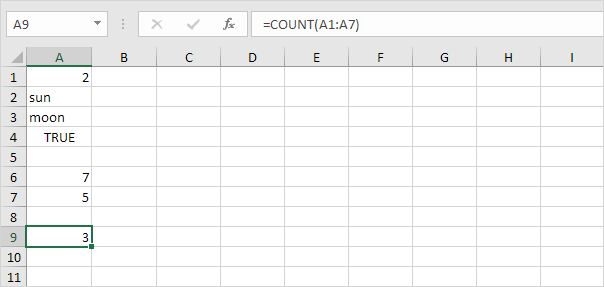


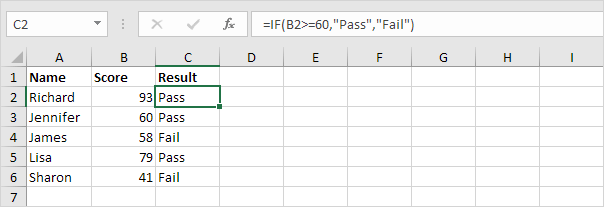
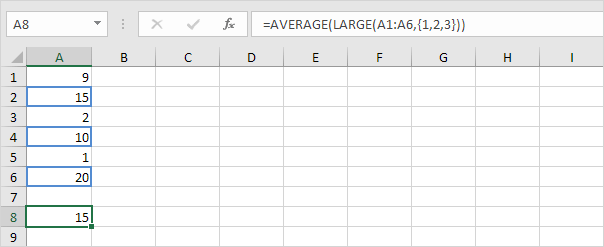
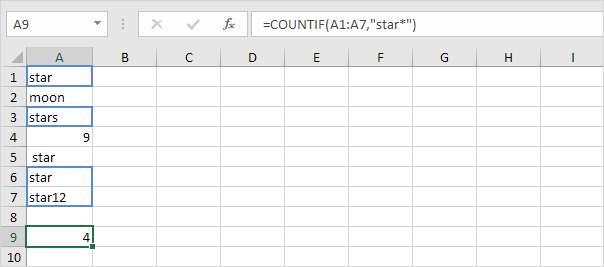
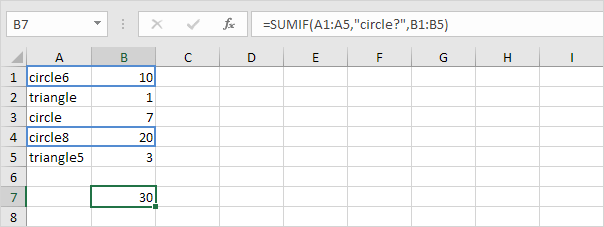
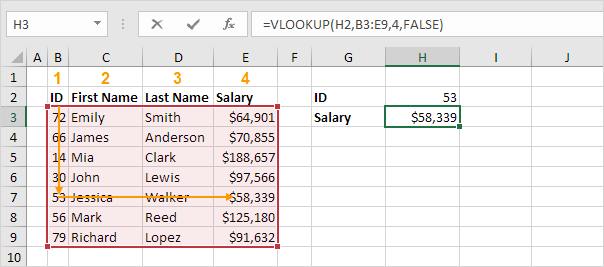


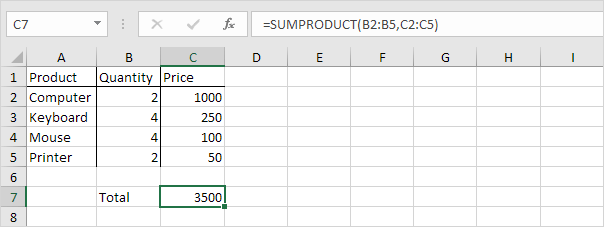





















































 Atanas Yonkov Blogger, Web Developer
Atanas Yonkov Blogger, Web Developer 